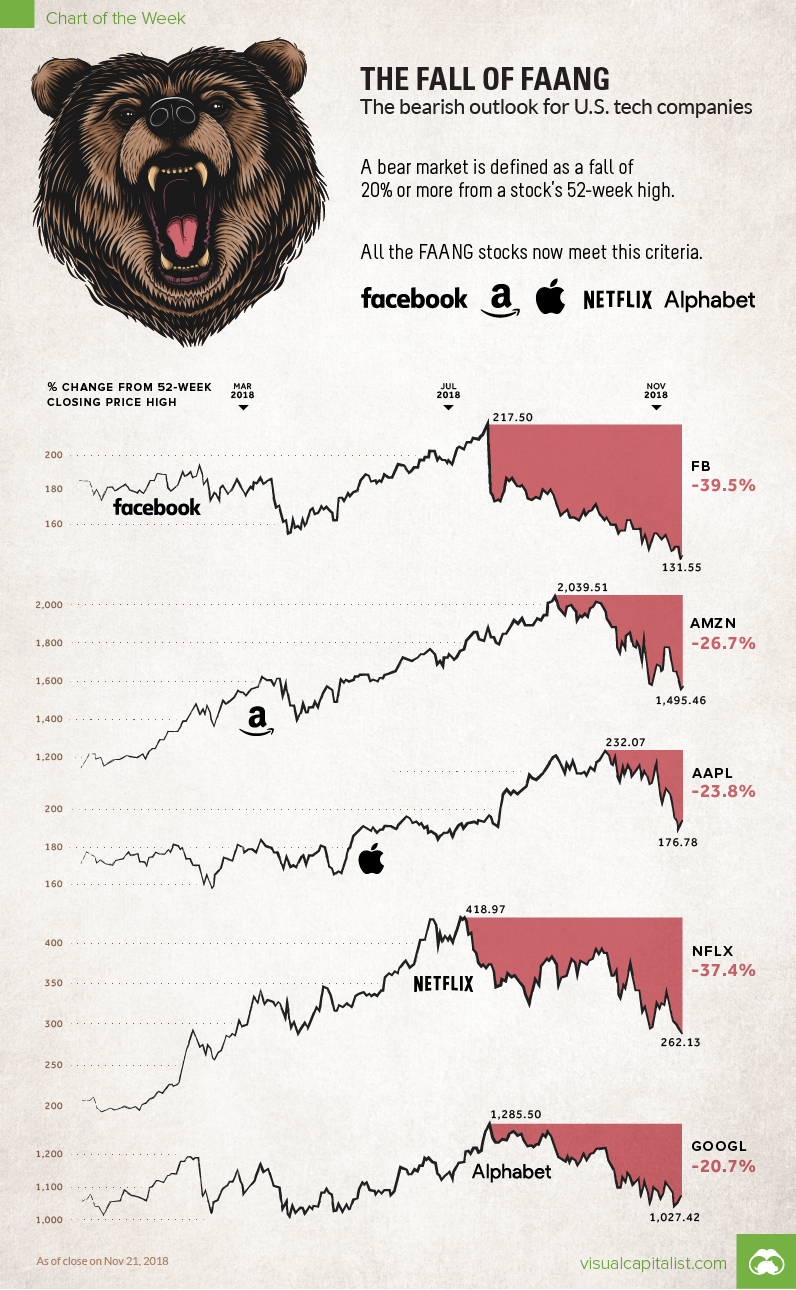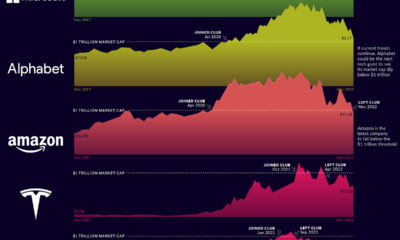Visualizing the Bear Market in FAANG Stocks
The Chart of the Week is a weekly Visual Capitalist feature on Fridays. What goes up, must come down. But in the financial world, this feeling of euphoria can be turned upside-down very quickly. Since the summer, the five tech giants combined have lost close to $1 trillion in market capitalization from their peaks. Now the FAANG stocks have officially slipped into a bear market, with investors blaming rising interest rates, slumping sales forecasts, possible government intervention, and bubble-like valuations as reasons for the reversal in fortune.
The Damage Done
The generally accepted definition of a bear market is a 20% or greater decline from recent market highs. Facebook and Netflix have been in bear territory for months, but the remaining members of FAANG only just recently capitulated. Apple was the last to go – but with -24% in lost value since its peak on October 3, it is now in trouble as well.
Interestingly, this is the first time that the FAANG stocks have been in a bear market together, meaning this is uncharted territory for big tech and the wider market as a whole.
After the Gold Rush
While FAANG represents a small fraction of tech stocks available on the market, they do make up a significant percent of indices like the S&P 500 or the Nasdaq Composite. As a result, this slump can impact the rest of the market – and it manifests a more general malaise that other, less-beloved tech stocks must deal with. Unsurprisingly, the Nasdaq Composite – a technology bellwether – is feeling the pain as well:
The sentiment can also be seen in other tech names, some which have been slumping for awhile and others which have fallen into a funk only recently:
Even SaaS darlings like Salesforce.com can’t shake the trend – the stock entered bear territory itself on November 19th.
Tell Me Why
Why have investors soured, at least temporarily, on the tech stock universe? There are multiple narratives floating around, but the general gist is something like this: the current bull market in stocks is nine years long, and at some point the party will come to an end. Because the FAANG stocks traditionally trade at very generous valuations, they are likely to come back down to earth as economic conditions deteriorate. Further, the fears around FAANG stocks are seemingly being confirmed by recent news. For example, there are reports of Apple slicing orders for iPhones, a stagnant Facebook userbase, and other growth hurdles being experienced by these companies – and these reports are helping to fan the flames. Some experts see the slump as an opportunity to load up on discounted tech heavyweights – while others, such as early Facebook investor Jason Calacanis, say it is possible that the social network has already experienced its “Yahoo peak” in terms of relevance and valuation. on But fast forward to the end of last week, and SVB was shuttered by regulators after a panic-induced bank run. So, how exactly did this happen? We dig in below.
Road to a Bank Run
SVB and its customers generally thrived during the low interest rate era, but as rates rose, SVB found itself more exposed to risk than a typical bank. Even so, at the end of 2022, the bank’s balance sheet showed no cause for alarm.
As well, the bank was viewed positively in a number of places. Most Wall Street analyst ratings were overwhelmingly positive on the bank’s stock, and Forbes had just added the bank to its Financial All-Stars list. Outward signs of trouble emerged on Wednesday, March 8th, when SVB surprised investors with news that the bank needed to raise more than $2 billion to shore up its balance sheet. The reaction from prominent venture capitalists was not positive, with Coatue Management, Union Square Ventures, and Peter Thiel’s Founders Fund moving to limit exposure to the 40-year-old bank. The influence of these firms is believed to have added fuel to the fire, and a bank run ensued. Also influencing decision making was the fact that SVB had the highest percentage of uninsured domestic deposits of all big banks. These totaled nearly $152 billion, or about 97% of all deposits. By the end of the day, customers had tried to withdraw $42 billion in deposits.
What Triggered the SVB Collapse?
While the collapse of SVB took place over the course of 44 hours, its roots trace back to the early pandemic years. In 2021, U.S. venture capital-backed companies raised a record $330 billion—double the amount seen in 2020. At the time, interest rates were at rock-bottom levels to help buoy the economy. Matt Levine sums up the situation well: “When interest rates are low everywhere, a dollar in 20 years is about as good as a dollar today, so a startup whose business model is “we will lose money for a decade building artificial intelligence, and then rake in lots of money in the far future” sounds pretty good. When interest rates are higher, a dollar today is better than a dollar tomorrow, so investors want cash flows. When interest rates were low for a long time, and suddenly become high, all the money that was rushing to your customers is suddenly cut off.” Source: Pitchbook Why is this important? During this time, SVB received billions of dollars from these venture-backed clients. In one year alone, their deposits increased 100%. They took these funds and invested them in longer-term bonds. As a result, this created a dangerous trap as the company expected rates would remain low. During this time, SVB invested in bonds at the top of the market. As interest rates rose higher and bond prices declined, SVB started taking major losses on their long-term bond holdings.
Losses Fueling a Liquidity Crunch
When SVB reported its fourth quarter results in early 2023, Moody’s Investor Service, a credit rating agency took notice. In early March, it said that SVB was at high risk for a downgrade due to its significant unrealized losses. In response, SVB looked to sell $2 billion of its investments at a loss to help boost liquidity for its struggling balance sheet. Soon, more hedge funds and venture investors realized SVB could be on thin ice. Depositors withdrew funds in droves, spurring a liquidity squeeze and prompting California regulators and the FDIC to step in and shut down the bank.
What Happens Now?
While much of SVB’s activity was focused on the tech sector, the bank’s shocking collapse has rattled a financial sector that is already on edge.
The four biggest U.S. banks lost a combined $52 billion the day before the SVB collapse. On Friday, other banking stocks saw double-digit drops, including Signature Bank (-23%), First Republic (-15%), and Silvergate Capital (-11%).
Source: Morningstar Direct. *Represents March 9 data, trading halted on March 10.
When the dust settles, it’s hard to predict the ripple effects that will emerge from this dramatic event. For investors, the Secretary of the Treasury Janet Yellen announced confidence in the banking system remaining resilient, noting that regulators have the proper tools in response to the issue.
But others have seen trouble brewing as far back as 2020 (or earlier) when commercial banking assets were skyrocketing and banks were buying bonds when rates were low.



















